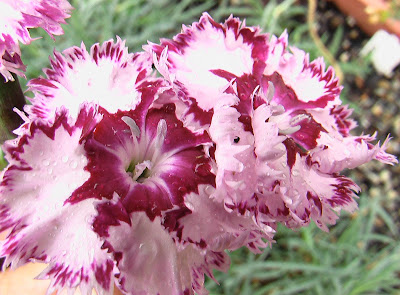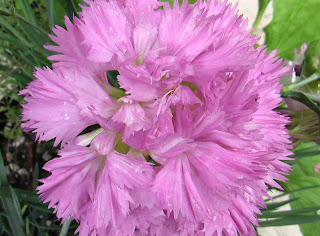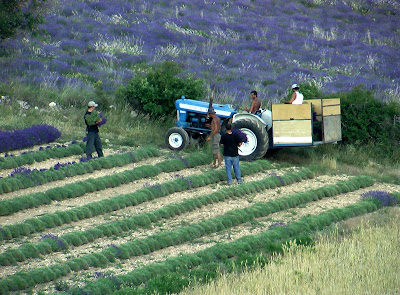It’s Rose Hip Time!
 |
| Rugosa 'Alba' |
Rose hips are the fruits of the rose, formed after the petals fall from the flowers. Quite a few rose varieties are so highly bred that they are more or less sterile and form no, or at most a few, hips, while the hips of many Hybrid Tea roses are unpromisingly hard, woody and light yellow. The wild species roses and their first and second cousin hybrids however are often arrayed with extravagant swags of jewel-like heps in glowing red or rich deep orange with rose-and-apple flavoured soft skins
Not only are these hips beautiful but they are also very rich in vitamin C. Up until the middle of the twentieth century children were still dosed on rose hip syrup, especially in winter. During World War 2, when Britain was cut off from Continental supplies of drugs, the women and children were asked to gather herbs from the countryside as well as seaweeds from the shores as a raw source of drugs. Along with approximately 750 tonnes of dried herbs such as dandelion root, elderflowers, and rose hips. Traditional delights made from rose hips included rose hip conserve (sometimes called rosehip marmalade), rose hip jelly, rosehip sauce, and a variety of sweet tarts.
 |
| Wild Rugosa Rose. Single and semi-double varieties produce the most hips. |
Rugosa roses were bred from the beach roses of northern Asia. In Japan they are known as the Ramanas Rose, and they are also found wild along the coasts of China, Korea and southern Siberia. These roses are not just beautiful, they are remarkable for many of their characteristics. Firstly they are wonderfully salt tolerant, capable of growing effortlessly along the edge of beaches, their leaves protected by a particularly thick cuticle (waxy outer covering). This has earned them the names of 'seaspray roses' and 'beach roses'. They have a natural thicketing habit if planted on their own roots or, if they have been budded, with their bud union below the soil level. Rugosas are the perfect choice for seaside and harbour side gardens, reducing erosion and acting as a barrier hedge while they also bloom prolifically from spring to late autumn. Rugosas are also extremely cold tolerant (down to as low as minus 30 degrees C for many varieties), yet they also grow well in high summer temperatures. Rugosas will grow in soils composed almost entirely of sand yet will thrive on quite heavy soils. (Add lots of compost to improve such sandy seaside soils - washed and composted seaweed is a particularly good soil improver.) The same thick cuticle which protects against salt spray, in combination with the wrinkled (rugose) texture of the leaves, allows the handsome foliage to shrug off disease. As a bonus Rugosa foliage has excellent autumn colouring.
All but the fully double flowered varieties (including rare hybrids such as the light yellow double flowered 'Agnes') bear huge glowing red hips which can be almost the size of plums. They are very rich in vitamin C and ideal for rose hip jam, rose hip jelly, rose hip syrup and other recipes. The flowers are large, beautiful, very prolific, borne in clusters, and have a fragrance that is a mixture of carnation and rose. All Rugosa varieties form handsome shrubs. Prune them in late winter, removing the oldest cane each year from the third season onward, together with any broken or dead canes, and then cut the remainder back by 1/3.
Rose hips (the fruits formed after the petals fall) are produced in abundance by Rugosa roses during the rose season, with hips and blooms often mingling together to create a wonderful display. The autumn harvest is the most bountiful. If using dog rose or eglantine hips for these recipes there will be a single harvest of much smaller fruit in autumn. Most Hybrid Tea roses have tough fibrous fibrous yellow to orange hips that are not well suited to these recipes.
Rose Hip Recipes
Garnered from my various magazine articles and book ‘Our Heritage of Old Roses’ ( by Judyth A. McLeod).
Rose Hip Tea
A delicious herbal tea high in vitamin C (and good for cold symptoms - although it isn’t necessary to have a sore throat to enjoy this treat) can be made by gathering, halving and deseeding the ripe hips. The hairs inside rose hips can be irritating, so use a teaspoon to clean out each half rose hip. I rinse them in water and pat them dry before placing them out in the sun arranged on cake cooling trays over newspaper or kitchen towelling The almost plum-sized Rugosa hips make this chore quite easy. If insects are hovering, cover the drying hips with fine netting or butter muslin. If drying time takes a few days, bring the trays inside overnight to avoid dew. Alternatively, dry the hips at the lowest oven temperature with the oven door open. Store the dried hips in an airtight container.
To prepare the tea. add a small piece of crushed cinnamon stick together with a small handful of crushed dried hips to the teapot, fill the pot with boiling water, cover, and steep for five minutes. In summer the crushed dried hips can be mixed with a handful of fresh mint, rather than a cinnamon stick, to make a very refreshing tea, served either hot or iced. Strain the tea before drinking (or chilling) and use a light honey such as clover honey as a sweetener.
Rose Hip Tart
.This recipe is modified from a 1671 book The Art and Mystery of Cookery Approved by the Fifty-five Years Experience and Industry of Robert May. Apples were not included in the original resipe which requireda much larger supply of hips. As apples and roses are both from the botanical Family Rosaceae and have compatible flavours this compromise works well. You may also like to try substituting the apple with peeled, sliced quince which has been simmered with a little sugar until soft, and then drained of excess juice. Quince turns a pretty shade of pink after cooking and has a rose scent.It resembles a very large golden rough-shaped pear and is available in autumn.
6-8 cups of ripe cleaned whole Rugosa hips
white castor sugar (we use raw sugar for most things but it would overwhelm the flavour in this recipe)
3-4 Granny Smith apples, depending on size
lemon juice
shortcut pastry (either bought or your favourite recipe)
1/2 teaspoon cinnamon
2-3 thinly sliced pieces of ginger (preferably in syrup, alternatively crystallised)
1 x 22 cm pie dish (preferably metal)
plain flour
Cut each hip in half and use a teaspoon to clean out the seeds and any hairs. Wash and pat dry. Peel and core the apples, then cut into slices around 50 mm wide, dipping them into lemon juice to prevent discolouration. Roll out pastry on a floured board to line the bottom of the pie tin. It should be around 2-3 mm thick and 30 cm wide. Roll out a second piece around 25 cm wide and the same thickness. Line the pie tin with the larger circle of pastry, pressing it gently into the sides and letting excess pastry overhang. Create the filling by alternating layers of apple slices and rose hips until they are used up. Finish with a generous sprinkle of sugar, about 2-3 tablespoons, the cinnamon and the ginger slices. Cover with the smaller circle of pastry and crimp the edges together with thumb and forefinger to make a neat edging. Use a sharp knife to remove any excess pastry around the edge. Place in the refrigerator for 30 minutes to chill the pastry (particularly if baking in the middle of an Indian summer), then glaze the surface with a little beaten egg,. Cut a small cross in the centre of the top to allow steam to escape, then sprinkle over with sugar and bake in a pre-heated oven at 180 degrees C until golden brown. Serve warm or cool with vanilla icecream or whipped cream.
Rose Hip Purée
If making a pie seems like too much effort, try serving scoops of good quality vanilla icecream into pretty glasses and top with this rose hip purée, adding a rose petal or two just before serving..
6 cups of ripe whole Rugosa hips, washed and cleaned
castor sugar (about 4-5 tablespoons)
juice of one lemon
1 vanilla pod
1 litre of water
Cut the hips into halves and use a teaspoon to clean out the seeds and any hairs Place the cleaned hips into a heavy bottomed saucepan and cover with the water which should be above the level of the hips. Gently simmer until the hips are soft (usually around 30 minutes). Add a little additional water if necessary while simmering and stir occasionally. Remove the pot from the heat and allow the pulp to cool slightly, then mash with a potato masher. Pass the pulp through a fine sieve (discarding the residue in the sieve) and return it to a clean pot. Add the vanilla pod, sugar and lemon juice, and simmer very gently, stirring regularly, until the sugar has dissolved and the purée has thickened. Cool, remove the vanilla pod (which can be cleaned and dried for another occasion), pace in a covered bowl or container, and store in the refrigerator for up to a week..
Rose Hip Syllabub
Syllabubs with their froth of cream and delicate flavour have been a delight of English cooking for centuries. The most favoured syllabub was made with rich cream, white wine, the juice of a lemon yogether with its finely grated rind, and sugar. Try this variation:
1 cup heavy whipping cream
juice of 1/2 lemon
1/2 cup thick rose hip purée
80 g castor sugar
1 teaspoon rosewater
Mix all the ingredients together in a basin, with the exception of the cream, and chill for 2-3 hours. Whip the cream until it is stiff and holding peaks. Gently fold the purée mixture through the whipped cream. Spoon into pretty individual glass dessert dishes or coupe champagne saucer glasses and chill well for an hour before serving, placing a couple of red petals on top of each dish a the last moment...
Rose Hip Soup or Nyponsoppa
This is a Scandinavian favourite, sometimes served simply for breakfast but more commonly as a dessert, often with little almond biscuits. Use the above recipe for the rose hip purée. Nypon means ‘rosehip’.
4 cups of rose hip purée, pressed through a fine sieve
2 tablespoons of a mild honey such as clover
2 tablespoons lemon juice’
1 tablespoon of cornstarch
5 tablespoons of Greek-style yoghurt or sour cream
Heat all the ingredients other than the yoghurt together. Add a little water before heating if the purée is too thick. Ideally this soup should be velvety in texture and similar to a thick soup. Taste and adjust the flavour if desired with additional honey or lemon juice so that the soup has just the right balance of sweetness and sharpness that is to your taste. Mix the cornstarch in just enough water to create a thick slurry. Stir this in, and then continue to simmer the soup until it is clear. Serve in bowls with a good spoonful of yoghurt or sour cream swirled over the surface.
Rose Hip Jelly
Rosehips contain a good level of pectin, the natural setting agent in fruit, but the level of pectin is variable depending on the type and ripeness of rose hips used. In this recipe, powdered pectin is used to ensure a gel is achieved. However, if wished, substitute by adding 3-4 apples, preferably still under ripe, to the hips before cooking., roughly sliced. To boost pectin levels, Choose fully ripened hips and wash in a colander before use.
An aside: For our American cousins, their expression‘canning’ is the equivalent of the English/Australian/New Zealand expression ,bottling’ – this seems to cause endless confusion as ‘canning’ conjures visions of preserving in tin cans. We know of one lady who spent three years in Victoria before returning to the United States considering Australia a bewildering and profligate backwater when shop after shop wre unable to supply her with ‘canning equipment’. The English ‘putting up’ of pickles, jams etc. can also cause confusion.
8 cups of ripe Rugosa rose hips, halved, all seeds removed with a teaspoon an hairs washed out of the hips
1/2 cup juice of lemon juice, freshly squeezed
6 cups water
1 packet pectin or I flat tablespoon powdered pectin
white sugar
1. Place the halved and cleaned rosehips into a saucepan with the water, bring to the boil, then turn the heat back, cover, and simmer until the hips are soft (approximately one hour).
2. Remove from the heat and roughly mash the contents of the saucepan (a potato masher is fine),
3. Either line a colander with a couple of layers of clean cotton tea towel, place the colander above a clean bowl, add the mashed heps and allow to drain into the bowl overnight or place the mash in the centre of a doubled square of cheesecloth, pull the cheesecloth up so that the corners meet, secure well with string , and hand thi sack over the back of a chair so that it drains into a bowl overnight. The beautiful clarity of a perfect fruit gel is spoiled if you squeeze out the last remaining liquid from the mash so resist the temptation. Measure out the volume of liquid and add an equal volume of sugar. It will probably be about 3 cupfuls.
4. Return the liquid to a clean large pot and add the sugar and lemon juice.
5. Sterilise the bottles by placing them on a tray in a 120 degree oven for 20 minutes minutes. Place plastic lids in a bowl and pour over with boiling water. Bottles can also be sterilised by placing them in a dishwasher at the hihest temperature.
6. Bring the contents of the saucepan slowly to the boil, stirring to ensure the sugar is fully dissolved (a volcanic explosion of undissolved sugar at the bottom of the pan is less than desirable). Bring to a rolling boil and add the pectin slowly so that it fully dissolves. After three minutes at a roiling boil, pull the pan away from the heat and test a a few drops on a saucer which has been refrigerated. (In our warm autumns pre-cooling the saucer is advisable.) If it forms a jellied blob which wrinkles when pushed with a finger at the side, it is ready to bottle. If not, return to the boil for 2-3 minutes and repeat the test for setting. Continue if necessary until a gel point is reached.
7. Line up the sterilised and still hot bottles on a cake rack or clean tea towel and use a clean scalded small jug to fill the bottles. Immediately cover with the scalded lids and tighten. Allow to cool completely, preferably overnight, tighten the lids further if necessary, and wash any jellied trickles off with hot water before drying and labelling. We have never had any contamination with this technique and the acidity and high sugar prevent bacterial contamination. If intending to keep the jars for many months (unlikely as they are much too popular), you may wish to further sterilise in a water bath (place the capped bottles on a rack inside a large pot and cover the jars with water so that there is 2-3 cm above the bottles; maintain at a boil for 10 minutes. NB With non-acid and/or low sugar bottling, sterilisation is absolutely vital as potentially dangerous bacterial growth can occur. Along with rose petal conserve, this jelly is a great moneymaker for festivals and specialty food shops.















